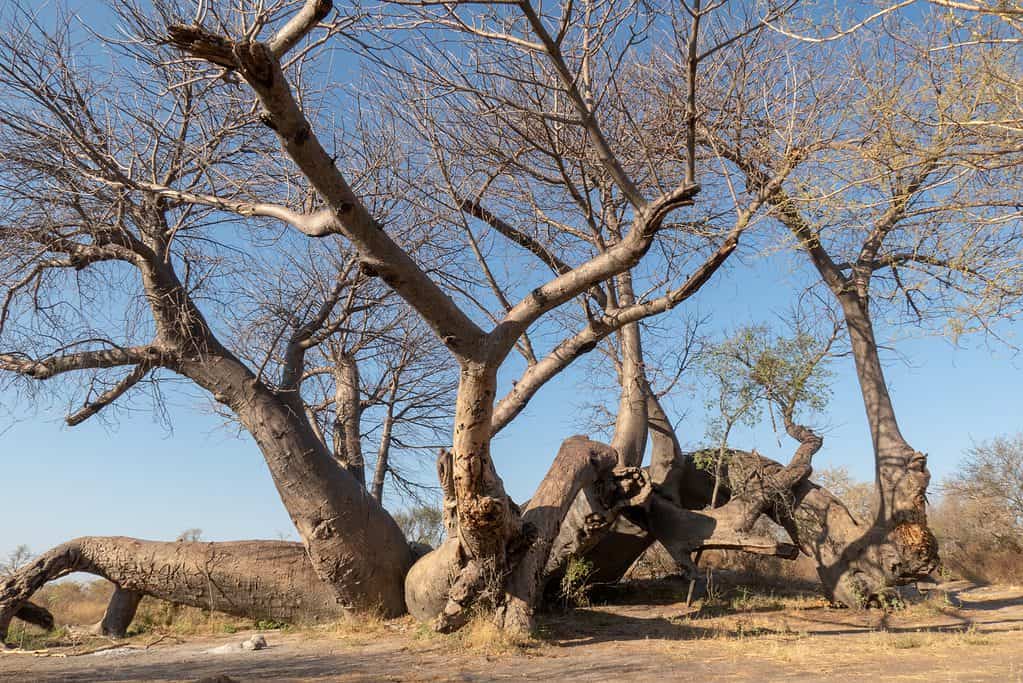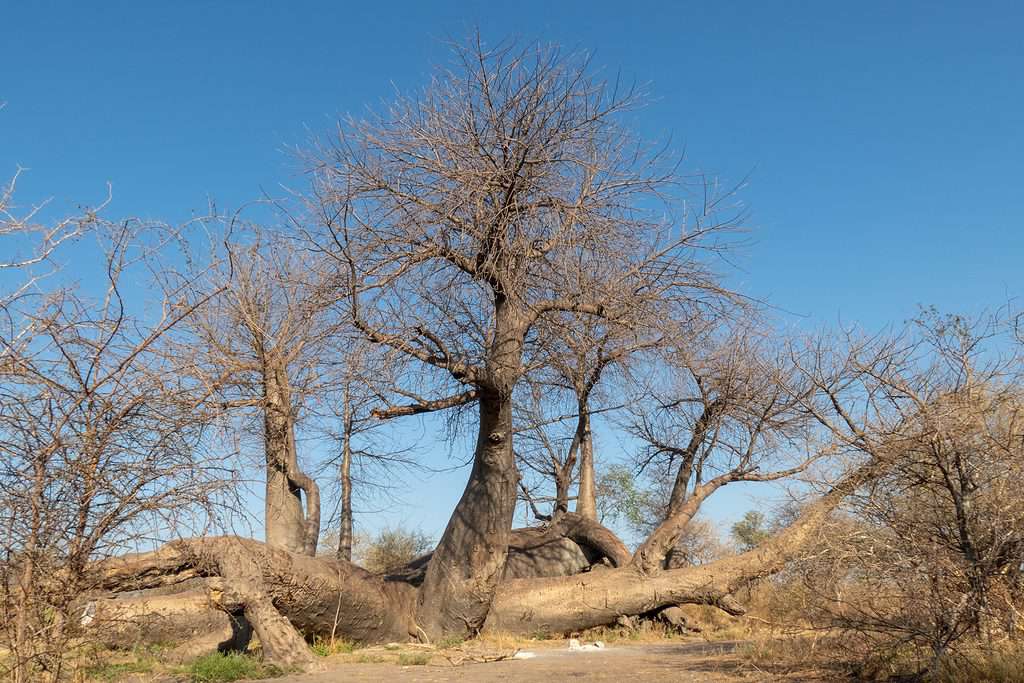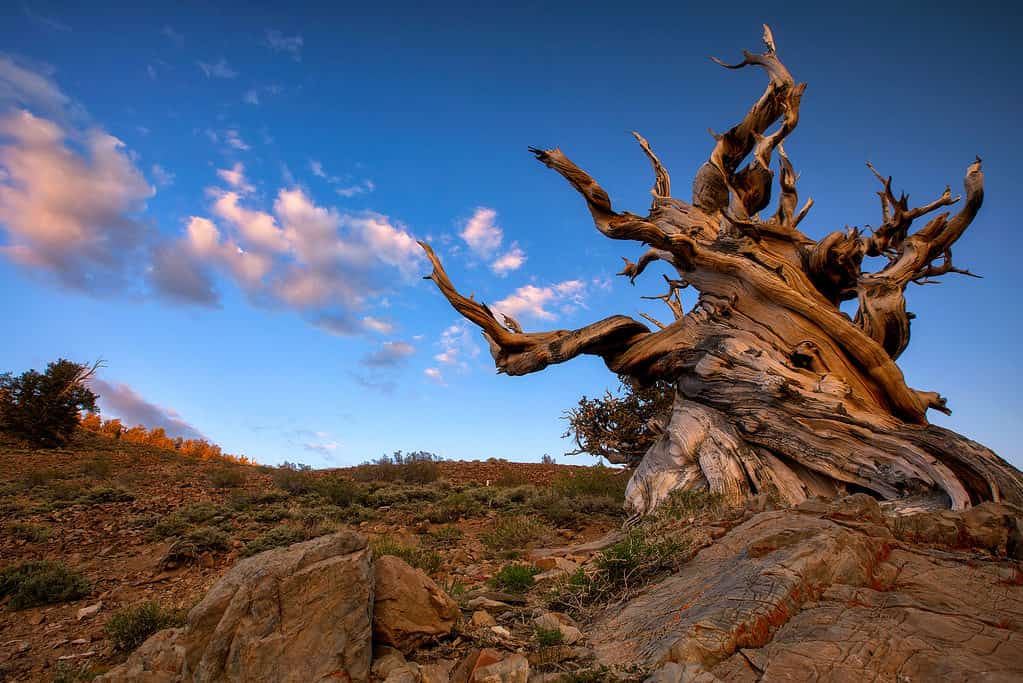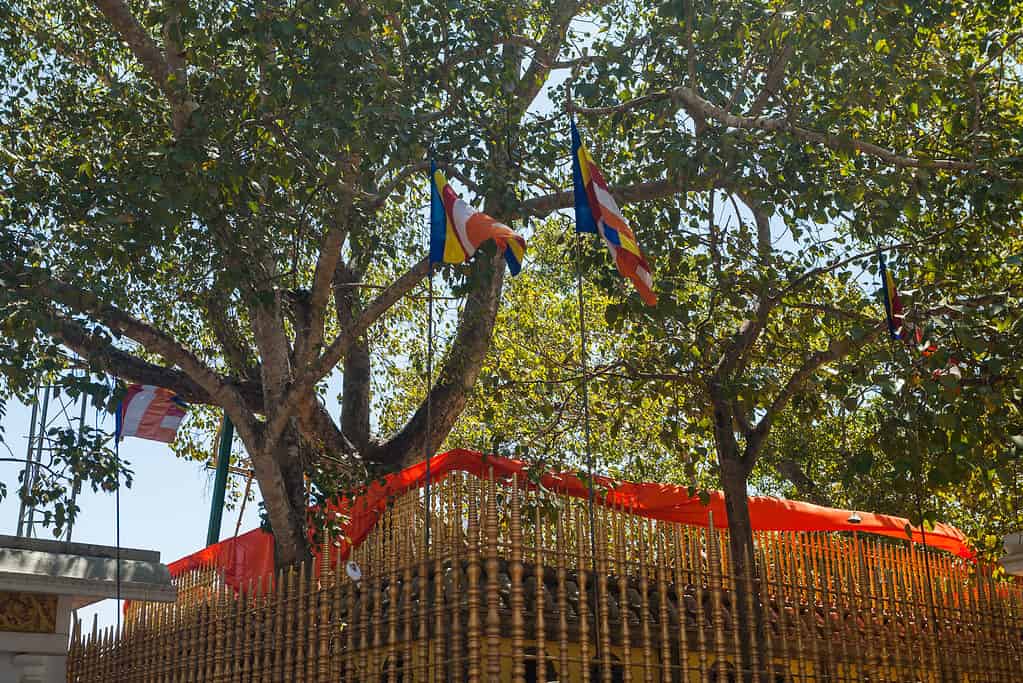Trees are a necessary part of sustaining human life on Earth. Africa contains unique ancient trees called baobabs (Adansonia digitata) that grow in savannahs. Is the oldest African baobab the longest-living tree on Earth?
What is the Oldest Baobab Tree on Earth?

The oldest tree in Namibia is the Dorsland Baobab.
©Kareen Broodryk/Shutterstock.com
The oldest baobab tree is an African baobab named the Dorsland Baobab. It is about 2,100 years old and it grows in the Khaudum National Park in Namibia.
It’s almost 100 feet around and it used to be almost 50 feet tall before it fell over. It’s still growing even though it toppled.
South African Dorsland trekkers stayed under the tree during their travels and left a carving in the trunk. It said 1883 since that was the year at the time. A later German expedition marked the tree in 1891 and carved a few people’s names into the tree along with the year.
Dorsland Baobab’s Health
There are concerns that this baobab is in bad health because the oldest baobabs around Africa are suddenly dying. Trees that have stood for a thousand years are splitting and dying in drastically higher numbers than what should occur statistically.
These trees hold hundreds of gallons of water in their trunks and climate change may be affecting their biology through changed precipitation levels. In other words, little rain may be drying these trunks out.
Freezing temperatures also quickly kill these trees as they cannot tolerate more than one icy day per year. Also, countries like Botswana, Namibia, South Africa, and Zimbabwe are heating faster than the rest of Africa.
Wider ranges in temperatures offered up by climate change may be taking a toll. The trees are self-contained ecosystems for a variety of animals so their loss affects more than just their species.
Since baobabs are so ancient, cultural myths are attached to these trees. Some of the indigenous people along the Zambezi River believe that the gods were mad at the trees because they were vain about how large they were. As a punishment, the gods flipped them upside down so that their roots were above ground.
Is the Oldest Baobab the Longest Living Tree on Earth?

While its age is impressive, the Dorsland Baobab is not the oldest living tree on Earth.
©Kareen Broodryk/Shutterstock.com
No, the oldest baobab is not the longest-living tree on Earth. Baobabs are, however, the longest-living tree in Africa.
Determining the age of baobabs is tricky and controversial. It’s believed that some of the dating methods are underestimating the age of these trees by a millennium.
There is debate about why the middle of a baobab tree decays. Since there is none of the oldest wood from the tree left to date due to this decay, its exact sprouting year is up for debate.
What is the Oldest Tree on Earth?

Methuselah is not just the oldest Great Basin bristlecone pine tree on Earth, it is also the oldest living thing on Earth.
©Bill45/Shutterstock.com
The oldest non-clonal tree on Earth is the Great Basin bristlecone pine (Pinus longaeva) named Methuselah. At an age of 4855 years old, it is not only the longest-living tree still on Earth, but it is also the longest-living tree ever. Its age was determined in 1957 by a core sample that was taken.
Bristlecone pines are slow-growing conifers that keep the same needles on their branches for up to 30 years to conserve energy. Methuselah’s ecosystem is harsh which helped it evolve the characteristics needed for long life.
An example is that its wood is extremely dense due to wind and cold temperatures. This protects them from rot, insects, and fungi.
The tree is around 9700 feet in elevation in the White Mountains in eastern California. It’s growing in the Inyo National Forest at the Ancient Bristlecone Pine Forest in Methuselah Grove. The exact tree remains unmarked so it isn’t destroyed by tourists.
What Is the Largest Baobab on Earth?
The largest and stoutest baobab tree alive on Earth is the Sagole Baobab. It’s also old at around 800 years of age.
In the local Bantu language called Venda, this tree is named Muri Kungulwa. This roughly translates to “roaring tree.”
The tree is located in South Africa east of Tshipise in Limpopo Province. It stands over 70 feet tall with a crown that’s about 125 feet around. Its circumference at the base is over 100 feet and it weighs around 60 tons.
Around 60 tons isn’t a lot for a tree as massive as the Sagole Baobab. The reason it’s so light is that the wood of baobabs is some of the softest and lightest wood available. There are hardwood trees that weigh much more.
There is an entrance fee of 50 ZAR to visit the Sagole Baobab. This equates to a little under 3 USD. Kids are half that cost.
Baobabs support a large quantity of life due to their massive size and domination over the open savannahs in which they grow. This tree in particular is home to an active colony of mottled spinetails.
What Is the Oldest Tree Planted by Humans?

The Jaya Sri Maha Bodhi in Sri Lanka is the oldest tree planted by humans.
©Honza Hruby/Shutterstock.com
The oldest living tree planted by humans is the sacred fig (Ficus religiosa) named Jaya Sri Maha Bodhi in Sri Lanka. The tree is in the Mahamewna Gardens in Anuradhapura. It’s believed this tree is 2309 years old.
It has a recorded history dating back to the day it was planted. It sprouted from the Bodhi Tree that Guatama Buddha sat under. A Buddhist nun had brought a branch from the original tree to a Sri Lankan king.
Today it’s surrounded by centuries of fences, walls, canals, and statues meant to protect and honor the tree. The gardens it lives in were created in the 300s BCE and it’s open to the public. There is no admission fee.
What Is the Longest-Living Clonal Species of Trees on Earth?

Utah’s Fishlake National Forest hosts the Pando clone of aspen trees.
©Reuben Jolley Photography/Shutterstock.com
The longest-living clonal species of trees on Earth is a colony of quaking aspen trees (Populus tremuloides) named Pando. Utah’s Fishlake National Forest hosts these trees.
Dubious sources say the tree roots creating the 47,000 trees making up Pando are 80,000 years old though they’re probably about 14,000 years old. All of the visible trees are genetically identical male clones attached to a larger root system. While the oldest standing trees aren’t even 2 centuries old, the root system is believed to be thousands of years old.
There isn’t much protection provided for the tree by humans so its new growth is subject to grazing by mule deer, cattle, and elk. This causes damage to the tree that may be putting it in jeopardy as old dying growth isn’t being replaced by anything new.
Up Next…
- Baobab Bonsai Tree
- Explore the Great Basin
- See No Evil, Hear No Evil, Speak No Evil Monkeys: Meaning and Origins
The photo featured at the top of this post is © Kareen Broodryk/Shutterstock.com
Thank you for reading! Have some feedback for us? Contact the AZ Animals editorial team.






